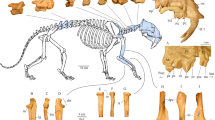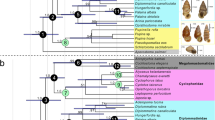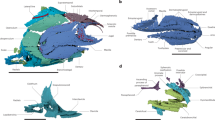Abstract
Replying to: J. H. Geisler & J. M. Theodor Nature 458, 10.1038/nature07776 (2009)
The analysis of Geisler and Theodor1 confirms our main phylogenetic result2, that raoellids are, or include, the sister group to cetaceans. Their study expands on our findings by inferring that hippopotamids are the sister group to the combined raoellid–cetacean clade, whereas our paper had explicitly stated that our data could not address the position of the extant artiodactyl families.
Similar content being viewed by others
Main
Geisler and Theodor1 place confidence in their results with regard to hippopotamids by stating that their analysis is consistent with “previous phylogenetic studies”. However, one of the two articles that they cite3 was published after the publication of our paper, and they do not cite a recent paper4 that disagrees with their (and our own) results.
Geisler and Theodor1 execute two analyses, one with equally weighted characters and one with down-weighted characters (Appendix Fig. 3 of their paper). They state that in both analyses Hippopotamidae is the closest extant taxon to Cetacea, but their Appendix is inconsistent with this statement. In the Appendix, a large polychotomy lies at the base of the raoellid–cetacean clade in the equally weighted analysis. This polychotomy dissolves when Andrewsarchus is excluded from the study, which results in a strict consensus tree where hippopotamids are indeed the sister group to the raoellid–cetacean clade. Instead of discussing this consensus tree, Geisler and Theodor1 mention that the equally weighted analysis yielded two most parsimonious trees: one showing hippopotamids as the sister group to the raoellid–cetacean clade and the other showing (apparently undeleted) Andrewsarchus as more closely related to the raoellid–cetacean clade than to hippopotamids. Notably, it took the deletion of Andrewsarchus before hippopotamids could be identified as the raoellid–cetacean sister group in the unweighted analysis of the Appendix of Geisler and Theodor1; the text seems to identify Andrewsarchus as a possible close relative of hippopotamids and this is consistent with another recently published cladogram4. Andrewsarchus is poorly known, and this may result in its unstable phylogenetic position, although it may still be part of the hippopotamid–raoellid–cetacean clade.
Geisler and Theodor1 agree with us that the phylogenetic link between cetaceans and raoellids is closer than that between cetaceans and hippopotamids, and we consider the former link to be more robust than the latter. We also believe that improving fossil collections of poorly known taxa is important in advancing understanding of cetacean relationships. Hippopotamids are certainly closely related to cetaceans, yet they appear about 35 million years after the first cetaceans, and their origins are in Africa, not the birthplace of cetaceans.
Geisler and Theodor1 further elaborate on our results by discussing the origin of osteosclerosis of limbs and bulla, calling this process pachyostosis (for definitions, see refs 5, 6). Osteosclerosis, but not pachyostosis, of the limbs occurs in hippopotamids, raoellids and pakicetids, whereas pachyosteosclerosis of the bulla occurs in raoellids and pakicetids, but not in hippopotamids. Experimental studies with lipoprotein-receptor-related proteins in transgenic mice suggest that pachyostosis and osteosclerosis are underlain by different genetic mechanisms7. The mechanisms that lead to such hyperostoses deserve further study, and such a study is necessary to test the speculation of Geisler and Theodor1 that hyperostoses of the limbs and bulla are related. Such a study should be rooted in a sound understanding of the developmental controls of bone formation, a field that is growing rapidly8 and that promises to elucidate cetacean evolution considerably.
References
Geisler, J. H. & Theodor, J. M. Hippopotamus and whale phylogeny. Nature 458 10.1038/nature07776 (2009)
Thewissen, J. G. M., Cooper, L. N., Clementz, M. T., Bajpai, S. & Tiwari, B. N. Whales originated from aquatic artiodactyls in the Eocene epoch of India. Nature 450, 1190–1194 (2007)
Geisler, J. H., Theodor, J. M., Uhen, M. D. & Foss, S. E. in The Evolution of Artiodactyls (eds Prothero, D. R. & Foss, S. E.) 19–31 (Johns Hopkins Univ. Press, 2007)
O’Leary, M. A. & Gatesy, J. Impact of increased character sampling on the phylogeny of Cetartiodactyla (Mammalia): combined analysis including fossils. Cladistics 24, 397–442 (2008)
Francillon-Vieillot, H. et al. in Skeletal Biomineralization Patterns, Processes, and Evolutionary Trends (ed. Carter, J. G.) 471–530 (Van Nostrand Reinhold, 1990)
de Ricqlès, A. & de Buffrénil, V. in Secondary Adaptations of Tetrapods to Life in Water (eds Mazin, J. M. & Buffrénil, V. de) 289–310 (Verlag Dr. Friedrich Pfeil, 2001)
Bodine, P. V. N. & Komm, B. S. Wnt signaling and osteoblastogenesis. Rev. Endocr. Metab. Disord. 7, 33–39 (2006)
Hall, B. K. Bones and Cartilage, Developmental and Evolutionary Skeletal Biology 760 (Elsevier, 2005)
Author information
Authors and Affiliations
Rights and permissions
About this article
Cite this article
Thewissen, J., Cooper, L., Clementz, M. et al. Thewissen et al. reply. Nature 458, E5 (2009). https://doi.org/10.1038/nature07775
Issue Date:
DOI: https://doi.org/10.1038/nature07775
This article is cited by
-
Negative thermal expansion and broad band photoluminescence in a novel material of ZrScMo2VO12
Scientific Reports (2016)
-
Hippos stem from the longest sequence of terrestrial cetartiodactyl evolution in Africa
Nature Communications (2015)
Comments
By submitting a comment you agree to abide by our Terms and Community Guidelines. If you find something abusive or that does not comply with our terms or guidelines please flag it as inappropriate.



